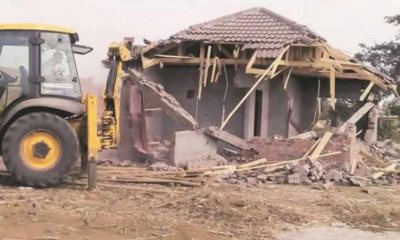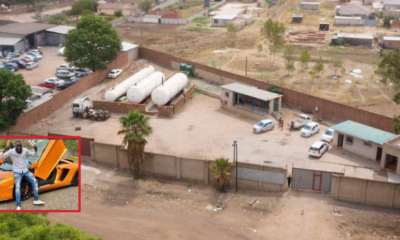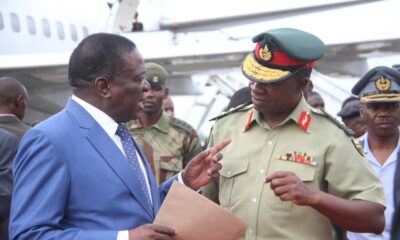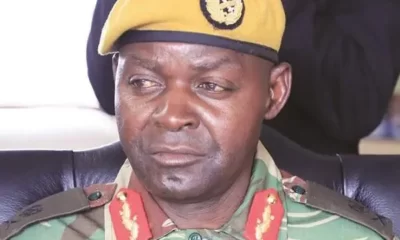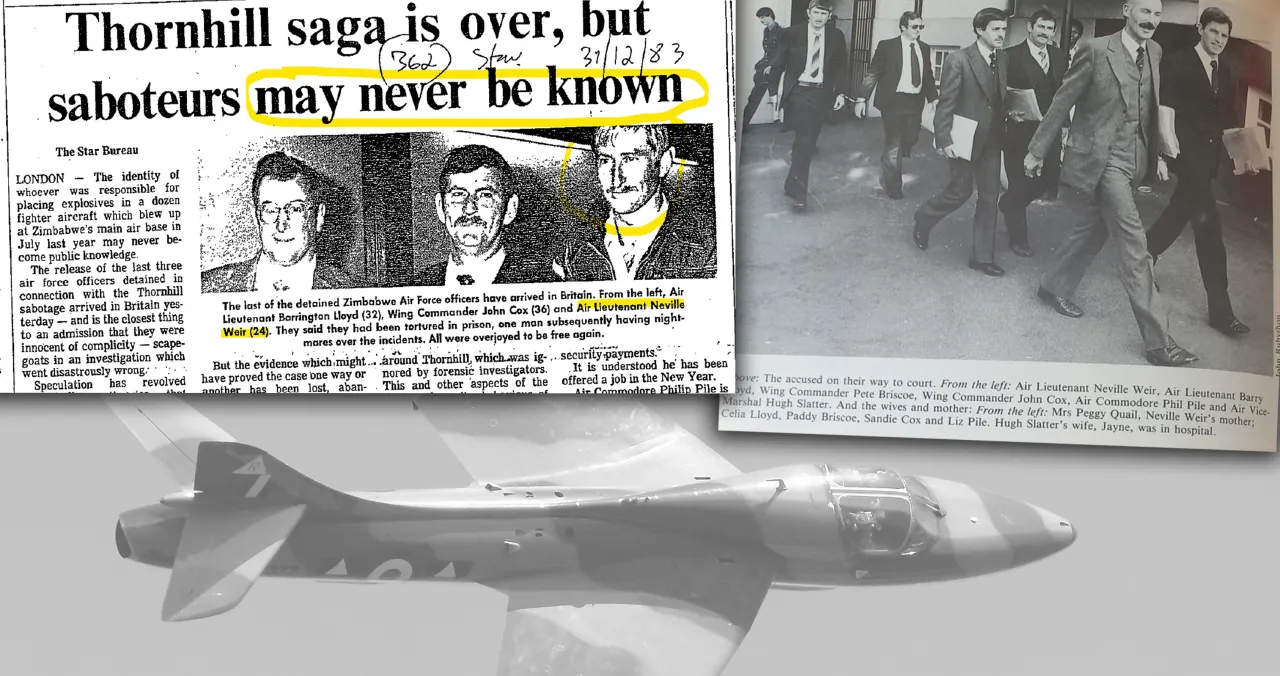
News
Thornhill bombing mystery resolved
Published
2 years agoon
By
NewsHawksIT was one of those mysterious dramatic military sabotage stories in which no-one ever thought the culprits would ever be named conclusively.
The late former president Robert Mugabe’s political ferocity and repression amid brutality and torture of many arrested suspects at the time failed to unravel the mystery.
Not even confessions extracted by torture could help to shed any light on the mysterious incident. In fact, that obfuscated the situation, allowing the real culprit to construct an alibi and to get away with it.
But 44 years later, former Rhodesian Special Air Services and later Britain’s Royal Air Force distinguished pilot Neville Weir — who collaborated with apartheid South Africa on the deadly mission — has been named as the destroyer, finally resolving the historic puzzle.
On the night of 25 July 1982, a deadly sabotage attack on Thornhill Airbase in Gweru, Zimbabwe’s Midlands city, damaged four Hawks, nine Hunters and a single FTB-337G. One Hawk was written off, another was repaired on site and the other two were returned to BAe in the UK for a rebuild.
Aircraft 602 was the airframe that was totally destroyed, while aircraft 601 was damaged but repaired on site. At the time of the incident, all four aircraft were just ten days old, having been delivered to the Zimbabwe Air Force on 15 July 1982.
On 31 August 1983, six white Air Force officers were acquitted on charges that they plotted to blow up the 13 Zimbabwean military aircraft, but they were immediately re-arrested and returned to prison.
This was to be Mugabe’s modus operandi dealing with Zapu and Zipra erstwhile liberation struggle comrades when he launched a crackdown on them around the same period as he beat the drums of Gukurahundi. The disregard for the rule of law was to haunt Zimbabwe for 37 years of Mugabe’s rule until he was ousted by the army in a military coup in November 2017.
Yet nothing has changed even then. Mugabe’s successor President Emmerson Mnangagwa, who was in charge of the Central Intelligence Organisation (CIO) amid the torture of accused as State Security minister during the Thornhill Airbase incident, continues from where his mentor left.
After years of investigation, research and combing through archives and piles of historical material, Dr Stuart Doran, a historian and executive director of the Institute for Continuing History (http://continuinghistory.org), a research centre that investigates major episodes of state-sponsored violence, provides the answer.
Doran is the author of a book on the early years of Zimbabwe’s independence — Kingdom, Power, Glory: Mugabe, Zanu and the quest for supremacy, 1960-87 — which was shortlisted for the Alan Paton Award for Non-Fiction. His book has some of the best insights and explanations on Gukurahundi in a growing repertoire of literature on the massacres now classified as genocide.
STUART DORAN
A South African government memorandum, squirrelled away by a former apartheid operative, has revealed the answer to a 42-year-old mystery: who was behind the devastating 1982 sabotage of the air force of newly independent Zimbabwe?
Much more than just another military episode in an unstable era, its violent after-effects hammered yet another nail into the coffin of the fledgling nation’s multi-ethnic experiment.
And the identification of the spy at the centre of it brings with it exquisite ironies for the Zimbabwean government and its critics — as well as uncomfortable questions for the UK military.
THERE was an international furore. It was global news for months. And it was a saga that marked the end of the honeymoon between Robert Mugabe’s regime and the West.
But the incident that triggered it has remained one of those unsolvable historical mysteries – until now.
In July 1982, saboteurs blew up most of Zimbabwe’s fighter aircraft during a nighttime raid on Thornhill, an air force base near the Midlands city of Gweru. Within minutes, the country’s fixed-wing airpower had been reduced to smouldering piles of wreckage.
The attackers had done their homework: 10 of the country’s 12 Hunter fighter jets were stationed at Thornhill, and the base had just received a consignment of British Aerospace Hawk fighter-trainers, purchased at enormous cost to the government’s strained fiscus.
The destruction was extensive.
Most of the Hunters were ruined, as was one of the Hawks, and the rest were severely damaged. Diplomats reported that “the entire operational fighter force” had been removed from service – and although a few aircraft in storage were resuscitated to fill part of the gap, the air force itself noted confidentially that it had “suffered a disaster”.
Rubbing salt into the wound, it quickly became clear that security at the base had been atrociously lax. It was evident from footprints and cut wire that a group had merely sliced holes through two fences, entered hangars and planted incendiary devices in the air intakes of the jets.
They had even sabotaged two aircraft sitting on the apron in front of Thornhill’s headquarters building. The attackers then left by the same route and jumped into a getaway car.
The raid came against the background of recent and major attacks in Zimbabwe by apartheid operatives – among them, the bombing of the ruling party’s headquarters and the sabotage of a military depot during which 70% of the military’s ammunition stocks had been destroyed.
The newly independent black government, hot with rage, arrested many white air force officers, some of them British citizens, and held them incommunicado, without access to lawyers.
It later emerged that a number had been tortured in order to extract false confessions. The public’s reaction in Britain was violent. So, too, was Mugabe’s response to representations by Her Majesty’s government about due process and the presumption of innocence.
The British considered cutting aid to Zimbabwe; the Zimbabweans threatened to throw such assistance back in their faces. When the airmen were eventually brought to court in 1983 after a torrid year for the bilateral relationship, they were acquitted.
Justice Enoch Dumbutshena, the first black Zimbabwean high court judge appointed by Mugabe, ruled that the confessions were inadmissible because they were obtained under torture.
That might have brought the matter to a close and allowed things to simmer down. The British had certainly hoped so – and had said so privately, to Mugabe’s displeasure.
They were soon to be reminded of a trait they were only beginning to understand: the more Mugabe was pressured, the further he dug in his heels.
Minutes after the airmen had celebrated with their families in the courtroom, they were handcuffed and hauled back to their cells.
The government had used emergency powers legislation, crafted during the period of white rule, which allowed it to detain without legal recourse those deemed to pose a threat to national security.
‘The law is a stupid ass’
The already blistering media firestorm in Britain reached yet another level of intensity – and Mugabe dumped a bucket of fuel on it a few days later during a visit to Ireland when he told English journalists: “[T]here is better justice there [in Zimbabwe] than you think you have in Great Britain. Why is there such concern about these men when there are other men detained as well? Is it because they are Mrs Thatcher’s kith and kin? … [T]he law and procedures we have inherited are a stupid ass. It says that it doesn’t matter if a person has committed a crime if there is evidence that the police have assaulted him or used any coercion. He might be a murderer or a rapist. In an African system, that is stupid … It is one of the stupidities of our colonial past.”
However, in the background, Mugabe had arranged for two airmen to be released and immediately deported to Britain. Eventually, all followed the same route. He had shown he would not be cajoled and — with other scandals on his hands — now sought to rid himself of an inconvenient diplomatic and ethno-political feud.
Yet the Zimbabwean government held to the view that the airmen, or at least some of them, were “guilty as hell”. Mugabe and his ministers remained convinced that officers of the predominantly white air force had connived with apartheid South Africa to destroy the country’s airpower from within.
Mugabe conceded that “irregular methods” had been used to extract evidence, resulting in the acquittal of the airmen on “a technicality”, but the government held to its belief that it had culled the air force of a spy ring that had done grievous damage to the nation’s security.
Among the white ex-Rhodesian community, outrage focused on the brutalisation of innocent men – and a popular notion was that the sabotage was probably the work of disaffected black “dissidents” loyal to Mugabe’s main political rival, Joshua Nkomo.
Others thought the South Africans had flown a special operations team across the border for a lightning strike on the base. Still others advanced the imaginative view that a North Korean army training team stationed in the country had deployed a group of sabotage specialists to do the job.
What nearly all ex-Rhodesian commentators agreed on – and repeated ad nauseam – was that it was inconceivable for airmen to connive in the destruction of machines they treasured. Some, living outside the country, and with a devil-may-care attitude towards multi-ethnic harmony, put a racial spin on the pop psychology.
Former Rhodesian Air Force chief of staff air vice-marshal Len Pink, accused by the Zimbabweans of being the “mastermind” behind the sabotage, fulminated from the safety of South Africa: “It really highlights the difference between a black man and a white man.
A white man does not go around destroying his air force … our integrity is way above that.”
But brash confidence and proof are not the same thing.
For 42 years, the truth has remained elusive; conclusive evidence about the identity of the culprits has never emerged.
Unexpectedly, that has now changed. Newly discovered documents show clearly who was involved, and how the sabotage was executed.
Excruciating contradistinction
The reality brings with it exquisite ironies for both the Zimbabwean government and its critics. It turns out that there was an insider — operating in cahoots with the South Africans — but only one.
For ex-Rhodesian theorists, the most excruciating contradistinction is that he was not only a white air force officer, but a pilot, and one of those acquitted in court.
For the regime, the scoresheet is also an embarrassment: its brutal hamfistedness brought only a 17% success rate – generously calculated as the ratio of guilty to prosecuted (one in six); in fact, at least 18 were arrested.
In court, that dismal percentage was predictably reduced to zero when the prosecution presented no evidence beyond the confessions and the court was compelled to rule on the question of admissibility.
Moreover, the government’s investigators lost interest in the real culprit when, under duress, he provided them with the pre-scripted fiction they had constructed to implicate an elaborate network of traitorous senior officers.
Had they conducted a more competent investigation, they might have not only secured a conviction but also uncovered the real espionage ring outside the air force, one that continued its work unmolested for many years afterwards.
Meanwhile, the Mugabe regime had briefly provided the world with a small window on its vast and casual disregard for collateral damage and the rule of law. Mugabe was right that there were “other men detained as well” — hundreds of them — innocent black supporters of Nkomo.
And thousands of black civilians were being killed by government forces in rural areas a short distance from Thornhill. Mugabe’s indignation was a Freudian moment of perverse self-righteousness.
He was incensed by the whiff of racial bias — at the intense scrutiny on his white countrymen by a white audience that had some knowledge of the much greater violence he was wreaking on his black compatriots.
Those are but a few of the many contradictions suggested by the Thornhill saga. But who was the mole?
Air lieutenant Neville Weir was one of a dwindling number of ex-Rhodesian servicemen who had remained in Zimbabwe, seemingly to help build the new nation. He was also a gifted pilot. Sent by the Zimbabwean government to Britain on a nine-month Hawk fighter training course in 1981, he finished at the top of the class, ahead of the Royal Air Force (RAF) trainees. When he returned, he took on further training so that he could fly Hunters as well as Hawks.
That was half of the story. Some of the other, less auspicious half was clear to the air force board of inquiry that was convened in the immediate aftermath of the sabotage.
Manned by white officers, the board recalled that Weir had appeared to have become disenchanted with the air force and Zimbabwe after his return from Britain, and had recently been seen in Pretoria at the recruitment office of the South African Air Force (SAAF) while on leave. Those events had prompted the commanding officer at Thornhill, group captain David Jones, to summon Weir and request a commitment from him; he was given two days to affirm his loyalty or hand in his notice. He chose the latter.
When the aircraft went up in smoke, he was only six days away from leaving the air force.
Weir was also a former member of Rhodesia’s elite Special Air Service (SAS). As such, he was better equipped than most other airmen to participate in an act of sabotage.
Obvious suspect
He was, then, a bleedingly obvious suspect — and that was why he was the first to be handed over to the police for interrogation. He was arrested on 26 July, the day after the attack. But two days later, the white detectives who questioned him reported that he would probably be released — apparently because he had a solid alibi.
Weir’s defence was that he had been at a party on the night of the raid, had consumed at least seven drinks, and was seen by other guests. He said he had then gone home to bed and was woken up by the sound of explosions. In addition, he remarked that he would hardly have remained within the reach of authorities if he had been the saboteur.
In the event, he was not released; black officers, with their political masters breathing down their necks, took over the case and told him that all they wanted “is for you to tell us about the small part you played, as you were forced into this from orders and threats from your seniors”.
After a series of physical assaults, he duly wrote his almost entirely fictional confession. That was a double irony: his bullheaded interrogators had paid no attention to what was a convincing alibi – but in their obtuseness, they had created another, better one for him.
Certainly, for ex-Rhodesian observers, the use of force and the manifest ineptitude of investigators served to undergird his original defence. It helped, too, that the other accused had also cracked under the pressure and signed bogus confessions.
He was, to them, just like them — another casualty of a regime that had revealed its true colours. Nothing has changed in the decades since.
Weir has continued to be willingly numbered among his innocent and abused colleagues. In the late 1980s, the victims collaborated in an authorised history of the event.
Penned by former Rhodesian government writer Barbara Cole, Sabotage and Torture described the inculpatory evidence against Weir and set it against the counterarguments he had given to investigators.
For him, it was a reiteration in the retelling, a doubling down, helped along by Cole’s self-assured repetition of old mantras.
“Weir’s whole life was flying,” she wrote, “and it was preposterous to think that he would have anything to do with destroying the things he loved.”
Indeed, Weir’s account of his assault by the Central Intelligence Organisation, related by Cole, laid it on thick with regard to his patriotism and loyalty: “He was beaten … but the police … did nothing to stop the beatings. Weir was beginning to feel betrayed by his own country … [Further] physical abuse simply hardened his resolve not to cooperate, but the mental pressure was the most difficult of all to endure. He felt he had been betrayed by his country; he was being unjustly accused.”
The proof
The alibis have now evaporated. A South African government memorandum, squirrelled away by a former apartheid operative, shows unimpeachably that Weir was the insider.
Gray Branfield, an ex-Rhodesian policeman and head of urban operations with Project Barnacle, a South African black ops unit, wrote to his superior on 22 June 1982: “A HUNTER pilot who is leaving the ZIMBABWE AIRFORCE on 31/7/82 has been spoken to by my man and is quite prepared to undertake the destruction of HUNTER AIRCRAFT at THORNHILL should this be required.
He feels it is quite feasible and should not be too much trouble … He feels that he himself could carry out the task.”
A transcript of a confidential interview with Branfield, found in the same collection of papers, provides further confirmation and adds considerable detail: “That [Thornhill] scene is quite delicate. The oke who was directly involved in it is in the RAF … [One of my agents in Zimbabwe] approached me … because he had a mate called Weir who was ex-SAS … He had been sent over on a Hawk course and had passed out top. Neville had approached [my man] — they were big mates … He wanted to get into the SAAF … Planning then started taking place. I got hold of [the agent and he] got hold of Neville. Neville said, ya well, okay … It came to a head in July … Because Neville had come back and only had a month to go before he left and came down to SA.”
Branfield also spoke explicitly about how they constructed an alibi for Weir: “He would go to a wedding and pretend to be totally arseholes [drunk] and be dropped off at home … [The agent] would pick him up from there. That was part of his cover that he’d been to this big wedding. In case any shit happened. Pick him up and me[e]t the team. They cut a hole in the [Thornhill perimeter] fence. They went in with Neville.”
Weir’s new post-Thornhill, post-Zimbabwean life began with his deportation to Britain in December 1983. A dual British-Zimbabwean citizen, he was employed by the RAF almost immediately, and was appointed to a permanent commission in 1985. He was promoted in 1986 and 1988, and retired in 1996, after 12 years of service.
Questions linger over how Weir was able to get a security clearance from the UK Ministry of Defence (MOD). Aside from the initial suspicions raised by the board of inquiry — of which the MOD should have become aware during its due diligence — the British high commissioner in Harare had been told by the airmen’s lawyer towards the end of the trial that he thought Weir might be lying. In a foreign office telex of mid-1983, QC Harry Ognall was reported to have “agreed that there was little doubt that there had to have been some collusion within Thornhill for the attack to have been successful, and who more likely than a former SAS officer …?” Ognall recalled that Weir had not “come over well in court”.
He reportedly “came very near to saying that he believed” Weir and one other defendant were “guilty as charged”.
The MOD’s security vetting team, and Her Majesty’s intelligence agencies, appear to have been asleep at the wheel. Whether Weir retained or renewed contact with the South Africans is a moot point. Prima facie, it is, perhaps, unlikely, given that he had been recruited by them for a specific task, and was soon incarcerated.
Further, his original intermediary died shortly after his release. Yet if his life as a South African agent began and ended with Thornhill, that was as much a product of bureaucratic ineptitude as his commissioning in the RAF – this time on the part of Pretoria’s intelligence services. Hiding a secret that would have destroyed his RAF career, Weir was a prime candidate for blackmail.
(Reached on his What’sApp number, Weir refused to reply to a set of detailed questions provided by Daily Maverick. His response: “Your accusations are ridiculous, if you slander me in any way I will take legal action against you.”)
Larger questions
The larger questions are systemic. The extent to which the British government hired southern African whites in the 1980s with intelligence connections to the apartheid regime — who they were, what secrets they may have stolen and how that was allowed to happen — is one that remains largely unexplored.
At the same time, the most important historical questions and impacts are Zimbabwean. Thornhill was both a reed in the wind and another nail in the coffin for the country’s post-independence multi-ethnic experiment.
The hope of many of Mugabe’s wartime adversaries and political rivals was that he would do as he promised at the outset and turn “swords into ploughshares”.
Eighteen years before the land invasions, Thornhill provided an indicator to the whites that he wouldn’t — and it was whites who didn’t share the same hope who had given him another reason why. For his black opponents, Thornhill’s aftermath was no revelation. It told them what they already knew, and what they were struggling to survive.
— Daily Maverick.
You may like

